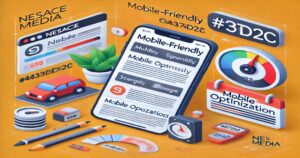Mastering SEO best practices for blog content is crucial for driving organic traffic and improving search visibility. This comprehensive guide will explore actionable strategies to optimize your blog posts, attract more readers, and elevate your content’s performance in search engine rankings.
Crafting Keyword-Rich Blog Titles and Headings
When it comes to SEO best practices for blog content, creating compelling titles and headings is essential for capturing both user and search engine attention.
Tips for Optimizing Blog Titles:
- Conduct thorough keyword research
- Place primary keywords at the beginning
- Keep titles concise and engaging
- Avoid keyword stuffing
- Use power words and emotional triggers
Utilizing H2 and H3 Headings:
- Organize content with clear H2 sections
- Break down complex topics with H3 subheadings
- Incorporate relevant keywords naturally
- Ensure headings accurately reflect content
By implementing these strategies, you’ll enhance your blog’s SEO structure and improve its visibility in search results.
Creating High-Quality and Engaging Blog Content
High-quality, engaging content is the cornerstone of successful SEO. Follow these key steps to ensure your blog posts stand out:
The Significance of Valuable Content:
- Provide unique insights and actionable tips
- Address audience pain points
- Include relevant statistics and expert opinions
Incorporating Multimedia Elements:
- Add images, infographics, and videos
- Optimize multimedia with descriptive filenames and alt text
- Create visuals that complement written content
Structuring Blog Posts for SEO Performance:
- Organize posts with clear introductions, body content, and conclusions
- Use bullet lists and subheadings for better readability
- Incorporate internal links to relevant content on your website
By focusing on creating valuable, well-structured content, you’ll not only improve your SEO performance but also keep readers engaged and coming back for more.
Optimizing Meta Descriptions and URL Structures
Meta descriptions and URL structures play a crucial role in improving click-through rates and search visibility. Here are some best practices:
Writing Compelling Meta Descriptions:
- Craft concise summaries of your blog post content
- Incorporate relevant keywords naturally
- Highlight the value or benefits of reading the post
- Ensure each meta description is unique
Importance of SEO-Friendly URL Structures:
- Use short, descriptive URLs with relevant keywords
- Separate words with hyphens for readability
- Avoid numbers or random characters
- Ensure URLs reflect blog post content
By optimizing these elements, you’ll increase the chances of users clicking through to your blog posts from search results.
Implementing Internal and External Linking Strategies
Effective linking strategies are essential for improving SEO performance and enhancing user experience. Here’s how to leverage them:
Benefits of Internal Linking:
- Helps search engines discover and index other pages
- Establishes a logical content hierarchy
- Uses descriptive anchor text with relevant keywords
- Regularly audit and update internal links
Strategic External Link Placement:
- Link to reputable and authoritative websites
- Provide additional context or supporting information
- Ensure external links open in new tabs
- Prioritize quality over quantity
When implemented thoughtfully, internal and external linking can boost your blog’s SEO performance and establish your website as a valuable resource. For example, you can learn more about effective link building strategies from established companies like Moz.
Mobile Optimization and Site Speed for Better User Experience
Optimizing your blog for mobile devices and improving site speed are crucial factors in SEO success. Consider the following strategies:
Importance of Mobile-Responsive Design:
- Utilize responsive web design for various devices
- Optimize fonts, images, and navigation for touchscreens
- Implement Accelerated Mobile Pages (AMP)
Strategies for Improving Site Speed:
- Compress images and videos
- Minimize HTTP requests
- Utilize browser caching
Enhancing User Experience Through Mobile Optimization:
- Focus on fast-loading pages and intuitive navigation
- Regularly test mobile performance
- Prioritize mobile optimization in your SEO strategy
By prioritizing mobile optimization and site speed, you’ll provide a seamless user experience and improve search engine rankings.
Monitoring and Analyzing SEO Performance for Continuous Improvement
Tracking and analyzing your blog’s SEO performance is crucial for making informed decisions and refining your strategy. Here’s how to effectively monitor and analyze:
Utilizing Tools for Tracking SEO Metrics:
- Implement Google Analytics for traffic and user behavior insights
- Use Google Search Console to monitor search performance
- Explore SEO tools like SEMrush, Ahrefs, or Moz for in-depth analysis
Interpreting Data to Make Informed SEO Decisions:
- Analyze key metrics like organic traffic and bounce rates
- Identify high-performing keywords and top-ranking pages
- Monitor backlink profiles and referring domains
Implementing a Data-Driven Approach for SEO Enhancement:
- Regularly review and adjust your SEO strategy
- Conduct A/B testing on various content elements
- Collaborate with your digital marketing team to leverage data insights
By embracing a data-driven approach, you can continually refine your SEO strategy and stay ahead in the competitive digital landscape.
Comparison of SEO Best Practices for Blog Content
| Best Practice | Benefits | Implementation Difficulty |
|---|---|---|
| Keyword Optimization | Improved search visibility | Moderate |
| Quality Content Creation | Higher user engagement | High |
| Mobile Optimization | Better user experience | Moderate |
| Internal Linking | Enhanced site structure | Low |
| Performance Monitoring | Data-driven improvements | Moderate |
Common SEO Mistakes to Avoid
| Mistake | Impact | How to Avoid |
|---|---|---|
| Keyword Stuffing | Penalization by search engines | Use keywords naturally |
| Duplicate Content | Decreased search rankings | Create unique content for each post |
| Ignoring Meta Tags | Lower click-through rates | Optimize titles and descriptions |
| Slow Page Speed | Poor user experience | Optimize images and code |
| Neglecting Mobile Users | Reduced mobile traffic | Implement responsive design |
Conclusion
Mastering SEO best practices for blog content is essential for driving organic traffic and improving search visibility. By implementing the strategies outlined in this guide, you can elevate your blog content to reach its full potential in the digital landscape.
Embrace Continuous Learning and Optimization:
- Stay updated on the latest SEO trends and algorithm changes
- Experiment with different techniques and make data-driven decisions
Prioritize User Experience and Value:
- Create high-quality content that resonates with your target audience
- Enhance user experience through mobile optimization and improved site speed
Leverage Analytics for Success:
- Utilize tools like Google Analytics and Search Console
- Interpret data insights to refine your SEO strategy
Remember, SEO is a dynamic field, and staying agile in your approach will lead to long-term growth and visibility for your blog content. For further insights on maximizing your blog’s SEO potential, consider exploring valuable resources from industry leaders like HubSpot.
Ready to take your blog’s SEO to the next level? Contact Nesace Media today for expert guidance and tailored strategies to boost your online presence and drive organic growth.




